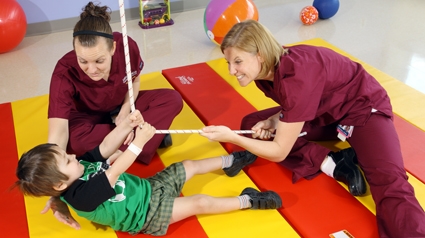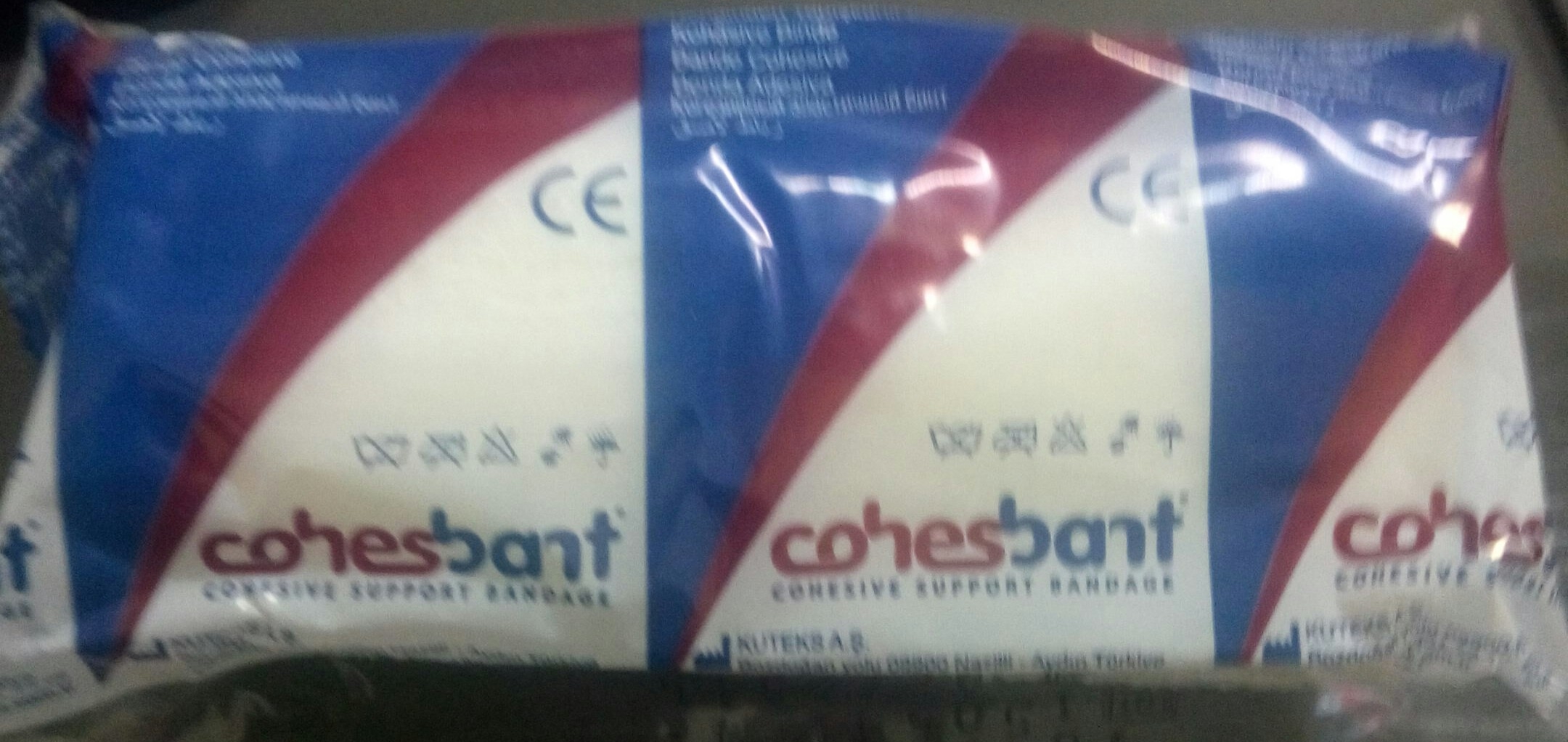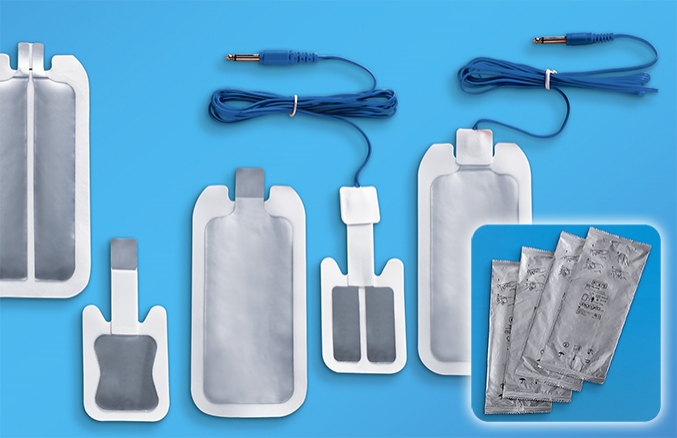Pediatric physical therapy assists in early detection of health problems and uses a limited variety of modalities to provide physical therapy for disorders in the pediatric population. These therapists are specialized in the diagnosis, treatment, and management of infants, children, and adolescents with a variety of congenital, developmental, neuromuscular, skeletal, or acquired disorders/diseases. Treatments focus mainly on improving gross and fine motor skills, balance and coordination, strength and endurance as well as cognitive and sensory processing/integration.
Conditions include:
Developmental delay
a lag in development in which a child exhibits a functional level below the norm for his or her age. A child may have an across-the-board developmental delay or a delay in specific areas. It is possible that a child with a developmental delay who receives services, will not develop a disability; whereas if the same child is not treated professionally, the delay may become a disability. Development delay is measured by appropriate diagnostic instruments and procedures in one or more of the following areas: cognitive development, physical development, language and speech development, psychosocial development, and self-help skills
Cerebral palsy
a genetic disorder that can affect the ability of an afflicted child to move his or her body in a usual manner. As with the vast majority of genetic disorders, cerebral palsy is not curable, however there are treatment options available to improve the quality of life for those individuals who have been inflicted by this disorder. The three most common forms of the disorder are spastic cerebral palsy, athetotic cerebral palsy and ataxic cerebral palsy. In the first one stiff muscles affect the movement of the legs or as much as the entire body. In the second one, the entire body is affected by slow uncontrollable movements. The third type of cerebral palsy is the least common of the three and generally affects balance and coordination in the afflicted individual. Some people have a combination of a few types of cerebral palsy and their symptoms can include a lack of coordination, known as ataxia, a stiffness of the muscles and poor reflexes, difficulty walking, variable muscle tone, and a tendency to drool and have difficulty speaking or swallowing.
Hypotonia
"low tone" - a physiological state in which a muscle has decreased tone, or tension. A muscle's tone is a measure of its ability to resist passive elongation or stretching. It is most often seen in newborns (congenital) and infants, but it may persist through adolescence into adulthood. Another name for infantile hypotonia is "floppy baby syndrome." This refers to the tendency of a hypotonic infant's arms, legs,and head to "flop," or dangle loosely,when they are picked up or moved. CNS trauma and infection are perhaps the most common cause of hypotonia, both in infants and in children. Insult to the brain may occur prenatally (before birth), perinatally (around the time of birth), or postnatally (after birth).
In addition to low muscle tone, infants with hypotonia may also exhibit excessive flexibility of the joints (hypermobility), decreased deep tendon reflexes (e.g., tapping the knee joint produces little or no muscle jerk), and difficulties with sucking and swallowing. Children in whom hypotonia persists often show delays in gross motor skills such as sitting up, crawling, and walking. They may also have difficulties with coordination and exhibit speech delays. In some cases, symptoms may persist into adulthood.
Hypertonia
a condition marked by an abnormal increase in muscle tension and a reduced ability of a muscle to stretch. It is caused by injury to motor pathways in the central nervous system, which carry information from the central nervous system to the muscles to control posture, muscle tone, and reflexes. When the injury occurs in children under the age of 2, the term cerebral palsy is often used. Hypertonia can be so severe that joint movement is not possible. Untreated hypertonia can lead to loss of function and deformity.
Spastic hypertonia
involves uncontrollable muscle spasms, stiffening or straightening out of muscles, shock-like contractions of all or part of a group of muscles, and abnormal muscle tone. Itis seen in disorders such as cerebral palsy, stroke, and spinal cord injury.
Dystonic hypertonia
refers to muscle resistance to passive stretching (in which a therapist gently stretches the inactive contracted muscle to a comfortable length at very low speeds of movement) and a tendency of a limb to return to a fixed involuntary (and sometimes abnormal) posture following movement. It is seen is the different forms of dystonia and sometimes in Parkinsonism. Rigidity is an involuntary stiffening or straightening out of muscles, accompanied by abnormally increased muscle tone and the reduced ability of a muscle to stretch. This type of hypertonia is most common in Parkinsonism.
Hypertonia is often treated by drugs such as baclofen, diazepam, and dantrolene which help to reduce spasticity. Injections of botulinum toxin are a recent treatment for chronic hypertonia in cerebral palsy, spasticity, and other disorders. Rehabilitative treatment may involve range of motion exercises, and active stretching exercises. Dystonic hypertonia and rigidity can be treated with therapies directed to the underlying disorders.
Developmental Coordination Disorder (DCD)
a condition where children do not develop normal motor coordination (coordination of movements involving the voluntary muscles).
Developmental coordination disorder has also been called clumsy child syndrome, clumsiness, developmental disorder of motor function, and congenital maladroitness. It is usually first recognized when a child fails to reach such normal developmental milestones as walking or beginning to dress him or herself.
Children with developmental coordination disorder often have difficulty performing tasks that involve both large and small muscles; including forming letters when they write, throwing or catching balls, and buttoning buttons. Children who have developmental coordination disorder have often developed normally in all other ways. The disorder can, however, lead to social or academic problems for children. Because of their underdeveloped coordination, they may choose not to participate in activities on the playground. This avoidance can lead to conflicts with or rejection by their peers. Also, children who have problems forming letters when they write by hand, or drawing pictures, may become discouraged and give up academic or artistic pursuits even though they have normal intelligence.
There are six general groups of symptoms. These include:
- general unsteadiness and slight shaking
- an at-rest muscle tone that is below normal
- muscle tone that is consistently above normal
- inability to move smoothly because of problems putting together the subunits of the whole movement
- inability to produce written symbols
- visual perception problems related to development of the eye muscles
Children can have one or more of these types of motor difficulties.
Developmental coordination disorder usually becomes apparent when children fail to meet normal developmental milestones. Some children with developmental coordination disorder do not learn large motor skills such as walking, running, and climbing until a much later point in time than their peers. Others have problems with such small muscle skills as learning to fasten buttons, close or open zippers, or tie shoes. Some children have problems learning how to handle silverware properly. In others, the disorder does not appear until they are expected to learn how to write in school. Some children just look clumsy and often walk into objects or drop things.
Gross Motor Concerns
The term gross motor skills refer to the abilities usually acquired during infancy and early childhood as part of a child's motor development. By the time they reach two years of age, almost all children are able to stand up, walk and run, walk up stairs, etc. These skills are built upon, improved and better controlled throughout early childhood, and continue in refinement throughout most of the individual's years of development into adulthood. These gross movements come from large muscle groups and whole body movement.
Important aspects of gross motor control include development of posture, learning to stand and walk, learning to go up and down stairs, hopping, jumping and running. Working with a child how has limited gross motor skills in any of the areas mentioned, can help them with their coordination, as well as some social aspects of their life.
Copyright 2015 - Ronaj




